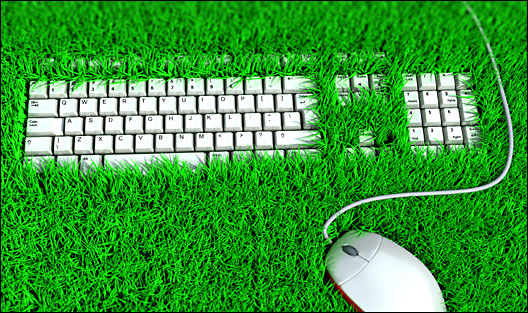
Hi-ho, hi-ho, it’s off to waste we go.
Nope, those aren’t the lyrics the Disney dwarves belted out en route to the daily grind, but in today’s world they’re right on the money. Most skyscrapers, offices, and cubicles are eco disaster areas, squandering massive amounts of energy, water, and paper while spewing out toxins and trash. It’s enough to make a person downright weepy (not to mention grumpy and wheezy).
You’re probably thinking there’s not much you can do to help, short of swearing off computers and jobs altogether — right? Wrong. With a few simple steps, every paycheck jockey on earth can help promote a healthier environment, inside the office and out. If the boss complains, point out (gently) that greening the workplace is a proven way to boost morale, productivity, and profits. Just call it the ultimate investment, with future returns that include, well, having a future.
Here’s how to start.
Level One: The Baby Steps
Be a switch hitter. Your parents may have been saying it for decades, but just in case they haven’t, we will: Turn off the lights. According to the U.S. Environmental Protection Agency, commercial buildings account for 18 percent of the nation’s greenhouse-gas emissions. A good portion of the problem is caused by leaving lights on in vacant rooms — that’s a habit shared by about 50 percent of us, surveys show. Switch off the lights whenever you leave your workspace empty for more than 15 minutes, and especially when you leave for the day. And while you’re flipping switches …

Turn it off.
Turn that computer off. Contrary to old wives’ tales, shutting down your computer each day will not cause any damage. One caveat: Your IT department might want computers left on for nightly geek procedures. You could try to convince them to do their backups during the day instead. Either way, set your machine to go into sleep mode after 15 minutes of inactivity. Every PC left on 24-7 over the course of a year results in more than 1,000 extra pounds of greenhouse gases. Since there will soon be 1 billion PCs in the world, the widespread use of sleep mode could prevent the annual release of hundreds of millions of tons of global warming gases, saving billions of dollars in the process.

Prints: not so charming.
Level Two: The Next Steps
Print to the finish. A few tips for navigating the “paperless office” of the new millennium (you know, the one that’s still filled with paper): Print fewer copies. Each year, the average American office worker uses 10,000 pages of copy paper (holy sheet!) and businesses devour 15 million toner cartridges — enough to stretch from New York City to Zurich, according to The Green Book. Use digital files instead and collaborate in work-sharing documents. If you must print, do it on both sides of the page, reuse paper that’s only been printed on one side, and look into the free (Windows-compatible) software from GreenPrint that helps you avoid printing blank or unwanted pages.
Give your gadgets a rest. If you use printers, scanners, and copiers only on an occasional basis, turn them off until you need them. Same with the gizmos that clutter your desk: Unplug things like your cell phone charger, lamp, and coffeemaker when you’re not using them (this is where a power strip comes in handy). In homes alone, the total energy lost from phantom power — the electricity drawn even when products are turned off and in standby mode — adds up to an estimated 65 billion kilowatt-hours of electricity each year, sending 87 billion pounds of carbon dioxide into the atmosphere, says the Union of Concerned Scientists.
Work on your lunch habits. To save money and resources, BYOL. Or if you walk or bike to the takeout place, ask the counter person to skip the earth-hostile Styrofoam packaging. If you have a lunchroom, stock it with reusable mugs and kitchenware; ask colleagues to donate items, if necessary. And if you’re lucky enough to have an on-site cafeteria, try to encourage the manager to invest in local or organic eats. (By the way, coffee junkies, snub that plastic stir stick. It’s estimated by some poor stir-stick-counter that 138 billion of them wind up in the trash each year.)
Chill. Heating and cooling systems suck up about 22 percent of energy used in the commercial sector, so if your climate controls are manually operated, turn them off when you don’t need them. Open a window! Wear a Jimmy Carter cardigan! Or better yet, urge your office manager to get an automatic thermostat that keeps temps right.

Take your plan to The Man.
Level Three: The Big Step
Push the envelope. Convince the powers-that-be to green up as many office supplies as possible, from toilet paper to electronic equipment to green power to, yes, envelopes. This isn’t always easy: Green products can be more expensive than conventional ones, especially where electronics are involved. But the payoffs in the long-term include lower energy bills, reduced carbon footprints, happier employees, great PR, and even government recognition. No wonder some of the biggest corporations in the world (here’s looking at you, Walmart) are going eco.
Bit by bit, byte by byte, your office can be a positive agent for change. And that’s just good business.
Resources
Green office guides and info
Grist’s Toiling Point archives offer information, examples of companies that are making changes, and advice on talking to your employer
Advice on saving energy in the workplace from Green Living Ideas, the U.S. Department of Energy, and the American Council for an Energy-Efficient Economy
Tips on greening your office from the Sierra Club, the Natural Resources Defense Council, and the U.S. EPA [PDF]
Other useful resources include the Green Workplace Blog, Alliance to Save Energy, Greenbiz, and Greening Your Office: From Cupboard to Corporation, An A-Z Guide
Green office supplies
The Green Office
Green Home Environmental Store
Office Depot’s “Buy Green”
Green Earth Office Supply
Energy Star product list
Green Guide product reviews
Eco-friendly paper
Grays Harbor Paper
Treecycle
New Leaf Paper
Dolphin Blue
Computer and power management info
Green Computing Guide from the University of Colorado-Boulder’s Environmental Center
Hints for computer power management from the Energy Star program
Climate Savers Computing Initiative


